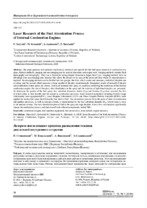| dc.contributor.author | Stezycki, P. | |
| dc.contributor.author | Kowalski, M. | |
| dc.contributor.author | Jankowski, A. | |
| dc.contributor.author | Slawinski, Z. | |
| dc.coverage.spatial | Минск | ru |
| dc.date.accessioned | 2020-02-04T07:51:55Z | |
| dc.date.available | 2020-02-04T07:51:55Z | |
| dc.date.issued | 2020 | |
| dc.identifier.citation | Laser Research of the Fuel Atomization Process of Internal Combustion Engines = Лазерное исследование процесса распыления топлива двигателей внутреннего сгорания / P. Stezycki [et al.] // Наука и техника. – 2020. – № 1. – С. 34-42. | ru |
| dc.identifier.uri | https://rep.bntu.by/handle/data/63820 | |
| dc.description.abstract | The paper presents test methods (mechanical, electrical and optical) for the fuel spray research in combustion engines. Optical methods, imaging and non-imaging can be used in laboratory and engine tests. Imaging methods include flash photography and holography. Their use is limited to testing droplet dimensions larger than 5 μm. Imaging methods have an advantage over non-imaging ones because they allow the droplet to be seen at the point and time where its measurement is required. Non-imaging methods can be divided into two groups: the first, which counts and measures, individual droplets one at a time, and the second, which measures a large number of droplets simultaneously. Exemplary results of research of droplet size distribution in fuel sprays are shown. In tests of atomized fuel spray, in conditions reflecting the conditions of the internal combustion engine, the size of droplets, their distribution in the spray and the velocity of individual droplets are presented. To determine the quality of the fuel spray, two substitute diameters Sauter (D32) and Herdan (D43) were selected, the first of which refers to heat transfer and the second to combustion processes. Laser research equipment including Particle Image Velocimetry laser equipment (PIV), Laser Doppler Velocimeter (LDV) and Phase Doppler Particle Analyzer (PDPA) were applied for testing fuel spray distribution for two kind of fuel. The atomization process from the point of view of combustion and ignition processes, as well as emission levels, is characterized by the best substitute diameter D43, which value is close to the median volume. The most harmful droplets of fuel in the spray are large droplets. Even a few such droplets significantly change the combustion process and emission of toxic exhaust components, mainly NOx. | ru |
| dc.language.iso | en | ru |
| dc.publisher | БНТУ | ru |
| dc.title | Laser Research of the Fuel Atomization Process of Internal Combustion Engines | ru |
| dc.title.alternative | Лазерное исследование процесса распыления топлива двигателей внутреннего сгорания | ru |
| dc.type | Article | ru |
| dc.identifier.doi | 10.21122/2227-1031-2020-19-1-34-42 | |
| local.description.annotation | В статье представлены методы испытаний (механические, электрические и оптические) для исследования распыления топлива в двигателях внутреннего сгорания. Оптические методы, техническая визуализация, системы без отображения цели могут быть использованы в лабораторных работах и испытаниях двигателя. Методы визуализации включают в себя съемку со вспышкой и голографию. Их применение ограничено размерами капель для тестирования, которые должны быть более 5 мкм. Методы визуализации имеют преимущество перед методами без отображения цели,потому что они позволяют видеть каплю в той точке и в то время, когда требуется произвести еe измерение. Методы без отображения цели можно разделить на две группы: первая, которая за один раз подсчитывает и измеряет отдельные капли, и вторая, когда одновременно производится измерение большого количества капель. В статье показаны типовые результаты исследований распределения капель по размерам в распылителях топлива. При проведении испытаний по распылению топлива в условиях работы двигателя внутреннего сгорания учитывались размеры капель, их распределение в распылителе, а также принималась во внимание скорость отдельных капель. Для определения качества распыления топлива были выбраны два подсменных диаметра Suter (D32) и Herdan (D43), первый из которых относится к процессу теплообмена, а второй – к процессу сгорания. Лазерный научно-исследовательский комплекс, включающий в себя лазерное оборудование для измерения скорости частиц (PIV), лазерный доплеровский измеритель скорости (LDV) и фазовый доплеровский анализатор частиц (PDPA), использовался для проведения испытаний по распределению распыления двух типов топлива. Распыление, с точки зрения процессов горения и воспламенения, а также уровней выбросов, характеризуется лучшим сменным диаметром D43, значение которого очень близко к средней величине. Наиболее вредными каплями топлива в аэрозоле являются капли крупного размера. Даже несколько таких капель значительно влияют на процесс горения и выброс токсичных компонентов, главным образом NOx. | ru |

